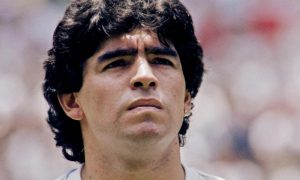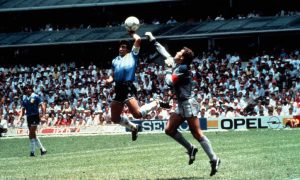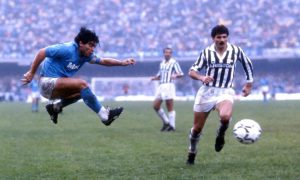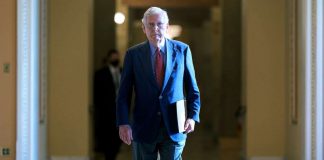NOVEMBER 25, 2020
Prodigiously skilled footballer who captained Argentina to victory in the 1986 World Cup

Diego Maradona before the start of the World Cup final between Argentina and West Germany in Mexico City in 1986. Photograph: AFP/Getty Images
Religious faith is a psychological prop for many a footballer, but Diego Maradona, who has died aged 60 after suffering a heart attack, took things further and came to believe in his own divinity. His multiple skills as creator, organiser and striker brought him worldwide acknowledgement as one of the best players ever known, an accolade tempered, in English minds at least, by the goal he scored for Argentina after 51 minutes of their quarter-final against England in the 1986 World Cup finals in Mexico.
Deemed by the referee to have been headed, the ball was actually punched over the line and the foul went unpunished. It was, said its scorer, “a little with the head of Maradona and a little with the hand of God”.
Four minutes later Maradona scored what would turn out to be the match-winner, a goal acclaimed as one of the greatest ever scored, a matter of 10.8 seconds, 44 strides and 12 touches, during which he dribbled past five England players, upended the goalkeeper, Peter Shilton, with a feint, and slipped the ball into the net.
“I felt like applauding,” was the rueful comment of the England striker Gary Lineker. With Maradona as captain and scorer of five of their 14 goals, Argentina went on to become world champions, beating West Germany in the final.

Diego Maradona’s contentious goal for Argentina during the 1986 World Cup quarter-final against England was scored, he said, ‘a little with the head of Maradona and a little with the hand of God’. Photograph: Popperfoto
A diminutive attacking midfielder who played in the No 10 position and who combined great acceleration, unrivalled vision, and a touch and ball control that he ascribed to the abnormal rotational capability of his ankles, Maradona captained Argentina to two World Cup finals, winning one, and gained numerous honours that included South American Footballer of the Year in 1979 and 1980 and the World Cup Golden Ball in 1986 and Fifa Goal of the Century in 20020.
In a career marked by glory, drama, indiscipline and a long-running cocaine habit, he was a controversial figure at Barcelona, worshipped as a god in Napoli, and kicked out of the 1994 World Cup finals in disgrace. He was also exploited commercially by clubs, associates, hangers-on and his national governing body, as well as by Argentina’s military regimes. According to Settimio Aloisio, the vice-president of Argentinos Juniors: “Maradona was a good diversion when things were difficult for the regime. He kept people happy. The Romans used the circus, our military used the football stadiums.”
Maradona was born in Lanús, Buenos Aires, and his childhood home was a shack in Villa Fiorito, a shanty town with a reputation as one of the most dangerous in the city. His father, Diego Sr, a low-paid worker in a bone-meal factory, was from Guaraní Indian stock; his mother, Dalma (nee Franco), known as Tota, was the descendant of poor immigrants from southern Italy.
As her first boy after three daughters, Diego Jr was doted on by Tota and his grandmother Salvadora, who drummed into him their Roman Catholic faith and reminded him of his responsibilities as the eldest son. Put to work early, he sold small items of scrap and discarded tinfoil from cigarette packets, but it was the leather football given to him for his third birthday by his uncle Cirilo that provided his route out of poverty.
Aged eight, Maradona’s prodigious skills brought him a trial with Francisco Cornejo, the trainer of Cebollitas, the youth team of the first division side Argentinos Juniors. Cornejo was left open-mouthed: “He seemed to come from another planet.” He had never seen a young boy display such talent. Given Maradona’s puny physique and strangely large head, at first he thought he was lying about his age and demanded to see his identity card. Reassured, Cornejo took him on and became his mentor at Cebollitas, with whom, in 1974, Maradona won the youth championship in Córdoba. Soon after he had his first contract with Argentinos Juniors, who promoted him to the main team.
He made his professional debut in 1976, 10 days before his 16th birthday, scored his first top-flight goal 25 days later and immediately became a teenage sensation. During his five years at the club he contributed 116 goals in as many appearances and was their leading scorer in every full season.
In 1979 he was the key man in Argentina’s victory in the World Youth Championship final against the Soviet Union, and at 20 he moved to Boca Juniors, where his 28 goals in 40 appearances helped the club win the Argentina Primera División Metropolitano in 1982, the same year he appeared in his first World Cup, in Spain. Small wonder that Barcelona promptly paid a world record fee of £5m for him; still only 21, he went to Spain in the face of the whole of Argentina protesting at his departure.
His turbulent two years at Barcelona brought him 38 goals and a 1983 Copa del Rey winner’s medal, as well as financial difficulties, the beginnings of his cocaine use and heavy drinking, a career threatening ankle injury inflicted by Andoni Goikoetxea of Athletic Bilbao, and increasingly frequent disputes with the club president, Josep Lluís Núñez. He was also the instigator of a mass brawl in front of King Juan Carlos of Spain in the 1984 Copa del Rey final after Barcelona lost to Athletic Bilbao. It was his last game for the club.
A £6.9m transfer fee that surpassed his own record took him to Napoli, and brought about a seven-year love affair during which time he inspired them to end the footballing hegemony of northern Italy; in 1987 they became the first southern club to win Serie A. The following season he was Serie A’s leading scorer. In 1989 Napoli won their first European trophy, the Uefa Cup, and a second league title followed in 1990. To the Neapolitans he possessed a godlike status in which he himself was prepared to believe; his image appeared in murals and shrines on city walls. The reality was darker; a cocaine addiction, connections with the Camorra – the Naples mafia – and a son, Diego Sinagra, the result of an extramarital affair, whom he refused for many years to acknowledge.

Diego Maradona in action for Napoli during a Serie A match between Napoli and Juventus in the mid-1980s. Photograph: Alessandro Sabattini/Getty Images
When he left in 1992, Napoli officially retired the No 10 shirt in recognition of his contribution to the club, even though his record was by then tarnished by a failed drug test for cocaine. By now in a precarious physical and psychological state, after a 15-month ban from football he spent a year playing for Sevilla FC in Spain before returning to Argentina, where first Newell’s Old Boys and then Boca Juniors handed him much needed lifelines.

Diego Maradona being carried by fans after winning the local championship with Boca Juniors in Buenos Aires in 1981. Photograph: AFP/Getty Images
Maradona’s international career never again hit the peak of Mexico 86. In Italy in 1990, sapped by an ankle injury, he was not the dominant force of four years previously, though he captained Argentina to the final, in which they lost 1-0 to West Germany. Four years later, in the US, he played only two games before testing positive for the proscribed drug ephedrine. Expulsion in disgrace terminated his international career, during which he had appeared 91 times for Argentina, scoring 34 goals.
After his retirement from football in 1997 (having scored 259 goals in 491 league matches for his various club sides), the body that had suffered years of physical abuse became bloated and grossly overweight, and in 2004 he was hospitalized with a suspected heart attack following excessive cocaine use.
Two years later he underwent gastric bypass surgery to reverse his obesity and, in 2008, after the resignation of the Argentina head coach, Alfio Basile, he was asked to take his place. Qualification was secured to the 2010 World Cup finals despite a 6-1 defeat, Argentina’s second worst ever, by Bolivia and a two-month Fifa ban given to Maradona for exploding into abusive language at the live post-match press conference. After Argentina were eliminated 4-0 in the quarter-finals by Germany, his contract was not renewed.

Diego Maradona as head coach of the Argentinian national team celebrating a goal during a Round of 16 match between Argentina and Mexico at the 2010 World Cup. Photograph: Kerim Ökten/EPA
In 2011 he became manager of the Dubai club Al Wasl in the United Arab Emirates before being sacked after just over a year in the job. Following a five year interregnum, in 2017 he was appointed head coach of Al-Fujairah in the UAE’s second division, moving the following year to the Mexican club Dorados de Sinaloa and in 2019 back to Argentina, to Gimnasia y Esgrima La Plata.
Despite his many misdemeanours and complicated personality, Maradona remained a hero in Argentina. “He offered to Argentinians a way out of their collective frustration and that’s why people love him,” said his former team-mate Jorge Valdano. “[That’s why he] is a divine figure.”
He married Claudia Villafañe in 1984; they divorced in 2004. He is survived by their two daughters, Dalma and Giannina, and his son, Diego.
• Diego Armando Maradona, footballer, born 30 October 1960; died 25 November 2020
Courtesy/Source: The Guardian










































































































